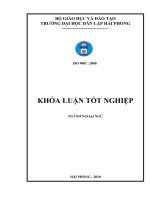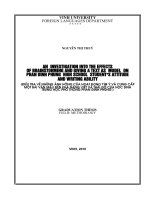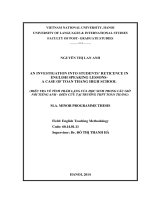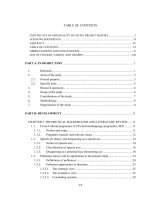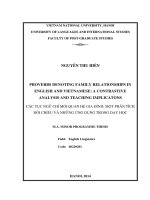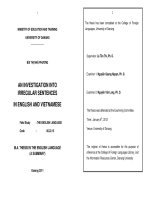An investigation into negative sentences in english and vietnamese a word grammar perspective
Bạn đang xem bản rút gọn của tài liệu. Xem và tải ngay bản đầy đủ của tài liệu tại đây (320.52 KB, 13 trang )
1
2
MINISTRY OF EDUCATION AND TRAINING
UNIVERSITY OF DANANG
The thesis has been completed at the College of Foreign
Languages, University of Danang.
NGUYỄN VŨ PHONG VÂN
Supervisor: TRAN QUANG HAI, Ph.D.
Examiner 1:
AN INVESTIGATION INTO
NEGATIVE SENTENCES
IN ENGLISH AND VIETNAMESE:
A WORD GRAMMAR
PERSPECTIVE
Examiner 2:
The thesis will be orally defended at the Examining Committee.
Field Study : THE ENGLISH LANGUAGE
Code
:
60.22.15
Time:
Venue: University of Danang
M.A. THESIS IN THE ENGLISH LANGUAGE
(A SUMMARY)
The original of thesis is accessible for the purpose of reference at
the College of Foreign Languages Library, and the Information
Resources Center, Danang University
Danang 2012
3
4
CHAPTER 1
1.2.2 Objectives
INTRODUCTION
To achieve the above aim, the following objectives are set:
1.1 RATIONALE
- Analyzing the structures of sentences containing negative
While studying English, learners may experience differences
words extracting from Vietnamese and English works.
in the ways of expressing ideas between these two languages. One of
- Identifying negatives devices in English and in Vietnamese.
the most difficult aspects they may encounter is how to use negatives
- Determining the aims of using negative sentences
correctly. At the early stages, learners have to find out the devices
- Finding out the functions of negative sentences in context.
which were used to express negation. Besides the usual negators like
- Identifying the similarities and differences between English
“no, not” in English or “không, chẳng” in Vietnamese, there’s still
and Vietnamese in using negative sentences.
many words denoting negative meaning are used. Sometimes,
1.3 RESEARCH QUESTIONS
learners make up sentences like what they always do in their mother
tongue; that way, they obviously make mistakes.
sentences?
Besides, sometimes negative sentences are used not for the
purpose of negating but for a variety of purposes which may really
challenge learners.
2. What are the similarities and differences about structures
and functions between English and Vietnamese negative sentences?
3. What are the advantages of applying the theory of Word
There are still more cases which Vietnamese learners may
confuse in using English negatives. To help learners avoid these
confusions, this study is carried on.
Moreover,
1. What are the negative devices in English and Vietnamese
beside
traditional
Grammar in analyzing sentences?
4. How to help learners overcome the difficulties in using
English negative sentences?
theory,
linguists
have
1.4 SCOPE OF THE STUDY
investigated on many theories to help learners study a foreign
We clearly realize that there are many aspects of using
language. In order to introduce the new theory to apply in the process
negative sentences. However, in the limitation of this thesis, we will
of studying a foreign language, Word Grammar theory is applied
not go far into all of these aspects. What we want to do is to focus on
throughout this study.
negative sentences containing negative words in English and
1.2 AIMS AND OBJECTIVES
Vietnamese.
1.2.1 Aims
This study aims to:
- Investigate the negative sentences in English and
Vietnamese, Word Grammar perspective.
1.5 THE SIGNIFICANCE OF THE STUDY
The study – An investigation into negative sentences in
English and Vietnamese: A word grammar perspective - is hoped to
5
6
contribute to the process of learning and teaching English when we
indirect and incomplete negation, special and nexal negation, the
have to deal with ways to use negative sentences, especially to help
meaning of negation.
the Vietnamese learners or speakers of English have a chance to learn
Traditional, structural and logical perspective of negation are
to observe the nature of negatives, and more importantly, to avoid
mainly investigated by grammarians and linguists, such as Diệp
misunderstandings when communicate with native speakers.
Quang Ban (2002) in “Ngữ pháp Tiếng Việt”, Mai Ngọc Chừ, Võ
1.6. THE ORGANIZATION OF THE STUDY
Đức Nghiệu, Hoàng Trọng Phiến (2000) in “Cơ sở ngôn ngữ học và
Chapter 1, Introduction
Tiếng Việt”, Hồ Lê (1993) in “Cú pháp Tiếng Việt”. Nguyễn Quang
Chapter 2, Literature Review
has investigated negatives on a contrastive analysis in English and
Chapter 3, Method and Procedure
Vietnamese in his master thesis. Also, Tran Van Phuoc in his doctor
Chapter 4, Discussion of Findings
thesis “Phân tích ñối chiếu câu phủ ñịnh tiếng Anh và tiếng Việt trên
Chapter 5, Conclusion
bình diện cấu trúc ngữ nghĩa” analyzed the differences and
CHAPTER 2
LITERATURE REVIEW
& THEORETICAL BACKGROUND
2.1. REVIEW OF PREVIOUS STUDIES
Gabriella Mazzon (2004) in “A History of English Negation”
similarities of syntactic-semantic features of negative sentences in the
two languages.
2.2. THEORETICAL BACKGROUND
2.2.1 Word Grammar (WG)
2.2.1.1 What is WG?
presents an extensive study of negation that combines both
Richard Hudson, who has studied and developed WG stated
synchronic and diachronic complementary analyses. Laurence R.
that WG is a general theory of language. Most of the work to date has
Horn and Yasuhiko Kato (2000) in “Negation and Polarity-Syntactic
dealt with syntax, but there has also been serious work in semantics
and Semantic Perspectives” deal with the syntactic features and
and some more tentative explorations of morphology, sociolinguistics,
scope of negation. Gunnel Tottie (1991) in “Negation English Speech
historical linguistics and language processing. Although the roots of
and Writing” classifies the uses of negatives in both oral and written
WG lie firmly in linguistics, and more specifically in grammar, it can
language. Adriana Pagano (1990) in “Negatives in Written Text”
also be seen as a contribution to cognitive psychology; in terms of a
investigates on the pragmatic perspective of negatives in written text.
widely used classification of linguistics theories, it is a branch of
Otto Jesperson (1917) in "Negation in English and Other Languages"
cognitive linguistics (Lakoff 1987; Langacker 1987; 1990; Taylor
lays the broad foundation for studies of negation later. He provides
1989).
general tendencies of negation, strengthened and weaken negatives,
7
WG semantic structures are based on named links
8
f) WG is mono-stratalist
(‘dependencies’) in a network, just as in many other theories such as
g) WG is cognitivist and prototypist
Frame Semantics and Cognitive Grammar.
h) WG is implementationist
As a theory of morphological structures, WG belongs to the
2.2.1.4 Default inheritance
family of theories which respect the syntactic integrity of the word
‘Default inheritance’ is the name for the basic logical
under slogans such as ‘morphology-free syntax’, ‘Word-and-
operation which makes generalizations possible in WG. Default
Paradigm morphology’, ‘lexical integrity’.
inheritance is closely related to the idea of prototypes, since the
WG sociolinguistic structures are based on links between
default characteristics for a concept are those of its (proto) typical
words and particular types of person or situation. Most theories do
members.
not recognize sociolinguistic structures as part of language.
2.2.1.5 Isa
2.2.1.2 Word
`Word' is the basic unit of language, not only in Word
Grammar but also in virtually every other theory.
The word has a word-form, the largest unit relevant
to segmental phonology (as opposed to intonation
‘Isa’ is the name of a very important and very
general relationship. Its name is based on the ordinary English ‘is a’,
as in She is a student. This sentence means that she is an example or
member of the general category ‘student’. This is what the ‘isa’
relationship means. It is the relationship between the concepts in an
The word is the smallest unit relevant to meaning.
inheritance hierarchy.
The word is the optimum unit for relating meaning to
2.2.1.6 Dependency
segmental phonology, being the largest unit for phonology and the
smallest for meaning.
The word is the unit of classification into `languages'.
The word is the unit for syntax.
2.2.1.3 The main tenets of Word Grammar
a) WG is lexicalist
b) WG is wholist
c) WG is trans-constructionist
d) WG is poly-constructionist
e) WG is relationist
A dependency is the relationship between a word and one of
its dependents - for example, if big depends on book, the relationship
between them is a dependency. So `dependency' is a kind
of relationship, in contrast with `dependent', which is the word that
has this relationship.
2.2.1.7 Adjacency Principle
In WG, Hudson shows a preliminary version of the
Adjacency Principle as follows: A word must be adjacent to any
other word, which is its head. More precisely: Adjacency that it
defined that A is adjacent to B provided that every word between A
9
and B is a subordinate of B. The Adjacency Principle rules out great
10
2.2.2.4 Double Negative
with difficulty because great is not adjacent to its head, difficulty,
In English, a double negative is the nonstandard usage of two
being separated from the letter by a word, with, which is not a
negatives used in the same sentence so that they cancel each other
subordinate of difficulty.
and create a positive.
2.2.2 Some notions are used in the research paper
2.2.2.1 Negation
According to Longman dictionaries of language teaching and
applied linguistics, negation is contradicting the meaning or part of
the meaning of a sentence. [1, p.354]
Jefferson states that the chief use of a negative sentence
In Vietnamese, double negative is used widely and conveys
both positive meaning and negative meaning, as in “Cấm không ñổ
rác ở ñây” and in “Không bao giờ không tán thành”.
CHAPTER 3
METHOD AND PROCEDURES
3.1 RESEARCH METHODOLOGY
being to contradict and to point a contrast. [20, p.4]
3.2 RESEARCH PROCEDURES
2.2.2.2 Negative sentences.
3.3 INSTRUMENTS FOR DATA COLLECTION
A negative sentence is a linguistic means used to express
negation, a basic category of human thinking, which is naturally
studied in logic and philosophy. [10, p.26]
According to Richard Hudson [8, p.288], negative verb is
one whose referent has the quantity zero - in other words, one which
doesn't refer to any actual situation, because it's not true.
Diep Quang Ban (2004) states that negative sentences and
3.4 DATA COLLECTION
3.5 DESCRIPTION OF POPULATION AND SAMPLE
3.6 DATA CLASSIFICATION AND ANALYSIS
3.7 RELIABILITY AND VALIDITY
CHAPTER 4
FINDINGS AND DISCUSSION
positive sentences are distinguished by the semantic features and
4.1 THE STATISTICS ON THE FREQUENCY OF USE OF
expressing forms in the view of traditional grammar.
NEGATIVE SENTENCES TYPES WITHIN THE SAMPLES
2.2.2.3 Negative Word and Classification
According to Downing and Philip Lock, there are two types
COLLECTED
According to English samples collected, negative statements
of negative words: nuclear negative words and semi-negative words.
take the highest rate of use (81.6%) while other types are much less
Nuclear negative words are explicitly negative words. Semi-negative
used. Among negative statements, predicate negation takes the top
words are such words that are not negative in appearance but in
place (49.2%) and subject negation takes the second place (26.13%)
meaning.
11
whereas object negation and complement negation account for only
3.6% and 4.13% respectively.
12
4.2.1.1 The Structure of Negative Statements
a. Predicate negation
Negative commands account for 9.33 % and take the second
range. The third place is for negative questions with 8.93%. In this
type, yes/no questions take the most percentage with 3.6%. Whquestions take the second place with 3.07% and with 2.53%, tag
questions take the least percentage. Only one sample (relatively
0.13%) is found in the type of double negative.
Figure 4.1: Predicate negation of ENS analyzed in WG
Figure above shows how predicate negation works in an
English auxiliary sentence:
Among Vietnamese samples, negative statements account
for the most percentage (83%). Within this type, predicate negation
takes the top place with 51.06 % and subject negation takes the
second place with 23.6%. Only 3.47 % of this type belongs to
complement negation. There is no sample of object complement.
With 10.67%, questions are in the second range with 4.13%
of Yes/No questions, 4.67% of Wh-questions and only 1.87% of
Tag questions.
Commands rank third with 5.07% in total.
Double negative with 1.35% takes the least percentage.
Figure 4.4: Predicate negation of ENS analyzed in WG
Figure above shows how predicate negation works in English
non-auxiliary sentence
Although there is no auxiliary in Vietnamese, there are some
cases of the same structure in Vietnamese negative statement (VNS)
which is demonstrated in the sample below:
4.2 THE STRUCTURES OF NEGATIVE SENTENCES IN
ENGLISH AND VIETNAMESE
4.2.1 The Structure of Negative Sentences in English and
Vietnamese
To summarize the structures of English and Vietnamese
sentences, we just choose some examples which are analyzed as the
representatives of its type.
Figure 4.5: Predicate negation of VNS analyzed in WG
b. Subject negation
13
The following samples demonstrate how subject negation
works in English as well as in Vietnamese:
14
d. Complement negation
Figure 4.16: Complement negation of ENS analyzed in WG
Figure 4.8: Subject negation of ENS analyzed in WG
Figure 4.18: Complement negation of VNS analyzed in WG
The two samples above illustrate how complement negation
in ENS and in Vietnamese works.
Figure 4.13: Subject negation of VNS analyzed in WG
c. Object negation
4.2.1.2 The Structure of Negative Questions
a. Yes/ No questions
These are two examples of Yes/ No negative question in
English and Vietnamese.
Figure 4.14: Object negation of ENS analyzed in WG
Figure 4.19: English negative Yes/No question analyzed in WG
This type of negation is not popular in Vietnamese. In the
process of conducting this material, we have not found any sample of
this type of negation.
Figure 4.21: Vietnamese negative Yes/No question analyzed in WG
b. Wh-questions
15
16
Figure 4.23: English negative Wh- question analyzed in WG
Figure 4.33: Vietnamese negative command analyzed in WG
However, in Vietnamese, there is the redundancy in using
negative words. Consider the sentence below:
Figure 4.25: Vietnamese negative Wh- question analyzed in WG
c. Tag questions
Figure 4.35: English negative command analyzed in WG
4.2.1.4 The Structure of Double Negative
Sometimes, more than one negator is used in a negative
sentence. While this type of sentence is widely used in Vietnamese, it
is really rare in English. The sample below illustrates double negative
in English:
Figure 4.27: English negative tag questions analyzed in WG
Figure 4.28: Vietnamese negative tag questions analyzed in WG
4.2.1.3 The Structure of Negative Commands
Figure 4.36: English double negative sentence analyzed in WG
Figure 4.31: English negative command analyzed in WG
17
18
English, a negative adverb is added after and auxiliary. However,
there is no auxiliary in Vietnamese. Furthermore, when negative
adverbs are put at the beginning, inversion often occurs in English,
which never appears in Vietnamese.
Figure 4.37: Vietnamese double negative sentence analyzed in WG
In the type of negative questions, yes/no questions rank first
in English with 3.6% while Wh-questions make the most percentage
4.3 THE AIMS OF USING NEGATIVE SENTENCES IN
(4.67%) in Vietnamese. Tag questions make the second rank in
ENGLISH AND IN VIETNAMESE
English while they are the least use in Vietnamese. Due to the fact
4.3.1 Negating
that there are no auxiliaries in Vietnamese negative sentences, the
4.3.2 Affirming
structure of tag questions in English is different from that in
4.3.3 Confirming
4.3.4 Giving directives
Vietnamese. In English, the tag depends not only on the subject of
the statement but also on its tense.
With negative commands, English negative sentences have
4.4 THE SIMILARITIES AND DIFFERENCES BETWEEN
the tendency to use the structure without subject while the subjects
ENGLISH AND VIETNAMESE NEGATIVE SENTENCES IN
are used more in Vietnamese. In Vietnamese, there is the redundancy
TERMS OF STRUCTURES AND USES
in using negative words in this type as illustrated in the sample “Cấm
Firstly, both English and Vietnamese negative sentences are
không ñược bỏ bữa” (See figure 4.2.3.5).
used for some certain communication functions, such as description,
Both English and Vietnamese negative sentences have the
denial rejection, asking or confirming information, making
type of double negative. However, the use of two negators in English
affirmatives statements or giving directives.
cannot be in the same constituents. If so, the sentence is considered
Among negative sentences, both English and Vietnamese
grammatically wrong. In Vietnamese, the appearance of double
ones, the negative statements take the most percentage than the other
negative both in the different and in the same constituents is normal.
types, accounting for 81.6% in English and 83% in Vietnamese.
The negators have relations to each other in one constituent to make
Predicate negation takes the highest range in comparison with subject
the sentence become affirmative. Double negative in Vietnamese is
negation, object negation, complement negation, which is 49.2% in
used mostly to strongly affirm the fact.
English and 51.06% in Vietnamese. However, while object negation
in English is used to make the statement stronger, it is odd when
using in Vietnamese. In addition, to form a negative statement in
19
4.5
SUGGESTIONS
FOR
20
STUDYING
NEGATIVE
SENTENCES
4.5.1 Negative word functioning as the complement
As analyzed above, the negative words can be the
complement of the auxiliaries in the sentence. While the main verb is
always the center of the sentence, the auxiliary (Au) modifies the
main verb (V) and shares the subject (S) with it. Therefore, the
auxiliary must precede the main verb. Then, the negative device (N)
Figure 4.42: Generalized form of negator as a pre-dependent of a
verb
In Vietnamese negative sentence, there is the same structure
as the generalized one above, as the example below:
functions as the complement of the auxiliary; thus, it must be
between the auxiliary and the main verb. The form can be
generalized as follow:
Figure 4.43: VNS with negator as a pre-dependent of a verb
In the case of some verbs like “be”, “have”, “need”, “dare”,
etc. which can be both the auxiliaries and the main verbs. Therefore,
depending on their functions, the negative words can be either the
complement of the auxiliary or the complement of the main verb.
Figure 4.42: Generalized form of negator as a verb complement
These cases can be illustrated by the two samples below:
Although in Vietnamese, there is no definition of Vietnamese
auxiliary, but as mentioned above, there are still some words which
have the function the same as auxiliary in English. Therefore, the
figure above can be used in case of Vietnamese negator.
4.5.2 Negator as the pre-dependent in a phrase
4.5.2.1 Negator as pre-dependent in a verb phrase
Not as in auxiliary sentence, in non-auxiliary sentence,
negative word directly modifies the verb. It stands before the verb in
the sentence. This type can be illustrated as follow:
Figure 4.44: Functions of negator in ENS with the verb “be”
4.5.2.2Negator as pre-dependent in a noun phrase
Consider three examples below:
21
22
Figure 4.45: ENS with negator as a pre-dependent in a noun phrase
In the first and second example, noun phrases function as the
subject and object in the sentence, negator “no” precedes and
functions as an adjective to modify the head noun.
Negator as the pre-dependent in a noun phrase can also be
found in Vietnamese negative sentences. The following example can
illustrate more this type.
Figure 4.47: ENS with negator as a post-dependent
The figure above shows how post-dependent works in
English negative sentences. In the first example, negator “not”
normally functions as the complement of the verb “be”. “Either”
modifies negator “not”.
The second example with the use of post-dependent “yet” to
Figure 4.46: VNS with negator as a pre-dependent in a noun phrase
4.5.3 Negative word functioning as the post-dependent in a
sentence
Consider these following examples:
modify “not” shows us another word to modify “not”. If the
combination of “not” and “either” means that something does also
not happen, the combination of “not” and “yet” indicates that
something does still not happen.
The first two examples show us how the negative devices
modify other devices in negative sentences. In the third example,
negative device “neither” functioning as post-dependent in
affirmative sentence to negate the sentence.
23
24
In Vietnamese, negator can also function as post-dependent
in a sentence. The two samples below illustrate more about it:
Figure 4.48: VNS with negator as a post-dependent
The two examples above are typical examples of Vietnamese
negators functioning as post-dependent in the sentence. In the
sentence “Nhà mày có thổi cơm trên gác ñâu”, negator “ñâu”
modifies the verb “có” and makes the sentence become negative
sentence. In the sentence “Bạn của con không sợ ma ñâu”, “ñâu” is
used to modify negator “không”. It is used to emphasize negative
word and make the sentence more natural.
In Vietnamese negative sentence, sometimes negative words
Figure 4.49: VNS with negator modified by some post-dependent
are modified by another word to strengthen the meaning of the word
CHAPTER 5
it modifies. Also, while English negators are often the single words,
CONCLUSION & IMPLICATIONS
Vietnamese negators sometimes consist of a phrase, in which many
5.1 A SUMMARY OF THE DEVELOPMENT OF THE STUDY
words modify the main negators. These samples below can illustrate
more this idea:
The paper with the title: “An investigation into negative
sentences in English and Vietnamese: A word grammar
perspective”, has investigated into the structures and the uses of
English and Vietnamese negative sentences. The similarities and
differences of these units are also determined. Some suggestions are
25
26
also provided after analyzing all samples. Finally, some implications
Both of these processes require extra activation, so they both
for language learning and teaching are also presented.
presuppose some degree of motivation.
5.2 A BRIEF RE-STATEMENT OF THE FINDINGS
5.3.2 Suggestion for language teaching
In English and Vietnamese negative sentences, the most
frequent type is predicate negation. Object negation is used popularly
Teachers should understand how learners retrieve just one
word. Also, teachers should know why learners have speech errors.
in English why it is rarely (or probably never) used in Vietnamese.
Next, we turn to other ways of using language, starting with
Vietnamese negative command has the redundancy of negation why
listening. When listening to another speaker, learners retrieve words
English negative command does not. Double negative is common
by working in the opposite direction. Learners hear a sequence of
used in Vietnamese while it is grammatically wrong in English.
sounds, and have to work out which word we have just heard.
Negative sentences are used to negate a statement, to create
affirmative statements, to confirm information or to give directives.
By classifying negative sentences by their negator’s position
in the sentence, the negator can be the complement in the sentence as
It is very significant to make the language itself interesting
because it guarantees that attention will be on the words and their
network connections.
5.4 LIMITATIONS OF THE STUDY
well as in a noun phrase. Next, negators can be the pre-dependent in
Firstly, the research only focuses on the small measure in
the sentence. Also, in the noun phrase, when negators directly modify
context of the theory WG in order to analyze the small aspect:
the noun, it precede the noun and become the noun’s pre-dependent.
English and Vietnamese negative sentences, mainly in the syntactic
Finally, sometimes, negators function as the post-dependent in the
properties. Secondly, the samples are not taken from wide range of
sentence.
sources; therefore, the conclusions cannot avoid subjectivity.
5.3 IMPLICATIONS OF THE STUDY
5.5 RECOMMENDATION FOR FURTHER RESEARCH
5.3.1 Suggestion for language learning
Further study can be conducted about semi or implied
Learners should make motivation in studying WG.
negative sentences. Moreover, the investigation on the similarities
Motivation decides where we channel activation. The need of
and differences in using negative sentences over each period of time
motivation is self-evident, but the theory of WG not only helps to
is an interesting topic. In addition, there is still lack of study
explain why it so, but also why motivation may be in short supplies.
conducted in the light of WG; further investigation into analyzing
other types of sentences is practical.


